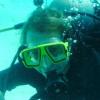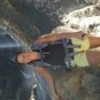WEEK TWO:
Baa: Kakaa Thila, Dharavandhoo Rock, Dhigu Thila, Dharavandhoo Thila, Horubadhoo Thila & Mutha Fushi
North Ari: Kan Thila, Mayaa Thila, Fish Head
South Ari: Moofushi Rock, Dhigaa Thila, Mahibadhoo Rock & Ari Beyru
Vaavu: Alimathaa Jetty
North Male: Alimathaa Jetty, Kandooma Thila & Kuda Giri Wreck
Kakaa Thila
Dharavandhoo Rock
The topography of this thila is what makes it special. It's located at the south west of Dharavandhoo and goes south to north along a narrow column for more than 200m. The top is at 5m on the shallower parts but goes down slowly until the bottom at 30m on the eastern part. The western part drops off rapidly and is where the main outcrops and overhangs are. Is also where the most life can be found, with lots of sponges, seafans, whips and black coral bushes. The place is very good for photography.
Dhigu Thila
Dhigu Thila is a narrow and long thila going from east to west, about 150m south east of Anga Faru. The top is at 6m and goes down to 30m, with a sharp drop off in the easter side.
In this dropoff there is a large cave at 13m full of black coral. All along the south part there are many big bright caves, between 20 and 25m, with whips and seafans. Inside use to be groupers, squirrelfish and wrasses and pipefish.
The thila ends with a sandy bottom where is easy to find black spotted stingrays. On the top of the thila there are some patches of fire coral.
Dhigalihaa Thila (Horubadhoo Thila)
The height of the thila is about 7 meters from the water surface and its length is around 80 meters. At a range on depth from 30 – 40 meters the ocean floor becomes quite level.
Drift dives from the open water is the diving technique that can be used when there is a strong current at Dhigalihaa Thila. There are many projections of the reef which can act as shelter from these currents thereby aiding divers.
Dhigalihaa Thila has an abundance of fish life and a large variety too. It attracts fish such as schools of jacks, and barracuda and when currents are strong, grey reef sharks as well. This reef is a place that is not visited by divers like other reefs and so much of it is truly unspoilt.
Muthafushi Thila
Overhangs are home to soft corals and anemones. Hard corals are in good condition and are also very colorful; soft white corals can also be seen. There are large schools of blue-striped snapper.
Kan Thila
The diving section of this reef is about 300 metres long and 20 metres wide, the depth ranges from 4 to 30 metres. The top of the reef is flat with a drop off on each side, steeper on the ocean side. The quality of the dive depends mostly on the visibility and the current; when the visibility is often 30 to 40 metres, it is an amazing dive.
The coral is very nice on the reef top at depth of 4 to 12 metres. There are small interesting caves on the inner side of the reef between 25 and 30 metres. There is a flat sandy bottom on the inner side of the reef with depths ranging from 9 to 35 metres, you can often find white tips sleeping on the bottom here.
The reef top is the best part for coral and to watch eagle rays, manta rays and huge tuna fish swimming by. When the current does not allow swimming along the top, the best solution is to follow the side from where the current comes. In the current you can find congregating on the plankton rich waters.
As this reef is at the edge of the atoll, the marine life here is very active. It is a busy hunting area, especially when the current is moderate to strong. In this case it is wonderful to watch the elegant movements of a large school of grey reef sharks that usually hover around the deep end of the thila at 35 metres. Other fishes to be found are groupers, big schools of snappers, jack fishes, fusiliers, barracudas and huge tunas.
Often one can see young turtles, small manta rays, eagle rays and dolphins (at the surface only).
Mayaa Thila
Maya Thila is about 80 meters in diameter and can easily be circumnavigated in one dive – if the current is favorable – although it is not uncommon for divers to spend the entire dive in one area to digest the incredible diversity of marine life; known for white tip reef sharks that circle.
The top starts at six meters and the reef edge drops from 12 meters to depths of 30 meters and more. Several coral outcrops occur on the northwest and south sides. There are many caves and overhangs all around the Thila. At a big cave on the north side is a feast of fish ranging from the white tips (which usually frequent the side of the reef where the current is strongest), dog-toothed tuna and great barracuda to blue-faced angelfish, Moorish idol, tall fin batfish, parrotfish, butterfly fish, clown triggerfish and lionfish. There are also other delights for the careful observer like stonefish and anglerfish.
A big rock on the south side has a meter wide swim-through at 19 meters.
On the reef top are many fusilier and blue stripe snapper and a large turtle is a regular around the reef. This dive is a fish watchers delight and the beautiful soft coral and gorgonians on the reef faces are a great attraction.
Fish Head
One of the worlds most famous dive sites, it's steep sides are spectacular with multi level ledges, overhangs and caves supporting many sea fans and black corals; it's top is heavily encrusted with anemones.
Fish Head is also protected as a Marine Reserve by the Maldivian government; although grey reef sharks are also quite common here, the smaller white tips are the center of attention, often wiith dozens of them circling the reef.
Beware of stonefish. The prolific Fish life at this protected marine area includes Fusiliers, large napoleons,trevally and Schools of hungry barracuda.
The main attractions are the grey-tip reef sharks, which can be seen up close.
Strong currents can make this a demanding dive and extreme care should be taken not to damage the superb but heavily used site.
Moofushi Rock
On the southside of the Moofushi channel a big plateau starts at the corner of the faru at 5 meter. This plateau slopes down towards an edge of 20 meter. On the east corner of the plateau, a big block is coming up to 16 meter. On the block you will be able to encounter our friendly Mantas from December to April. The mantas are using the block as a cleaning station, so observing these giants, turning and swimming around the block for an whole hour can be a common thing. But the divesite also offers another big variety of schooling fish, napoleon, white-tip and grey reefsharks. An easy divesite suitable for all level of divers.
Dhigaa Thila
Colorful soft coral and few gray reef sharks and barracudas.
Mahibadhoo Rock
Cleaning stations with Mantas
Beyrukandu Thila
This is a very long submerged part of the barrier of the atoll (about 600 m.). The top of it varies between 8 and 16 meters and is about 20 meters large. The current comes normally perpendicularly from the reef, so there is always a way to dive there, even when it is quite strong. Divers are protected from the current as soon as they reach 4 m. deeper than the top, on either side.
The best dive is on the top when there is no current. It is the best part for the coral and to watch eagle rays, manta rays and huge tuna fish passing close to the surface. When the current does not allow it, the best solution is to follow the side from where the current comes, where fishes hover to feed. The coral is particularly well preserved as the reef starts well under the surface and as such it is a beautiful garden.
There are a lot of shells, moray eels and all kinds of fishes hiding under big coral masses or in many small caves on the inner atoll side. It is the best place to see turtles and napoleon wrasses, often entire families together. It is also home to white tip reef sharks lying on the sandy bottom. Grey reef sharks can often be seen on the corner at a depth of around 30 meters or even sometimes on the top of the reef. Whale shark and dolphins have been seen here at times.
When the current is slight to moderate this is a perfect spot for all kind of divers, from beginners to experts, when the current is strong this dive should only be done by experienced divers as a fast descent to the reef is required. Once on the reef, it is easy
to dive on the side without current.
Alimathaa Jetty
Alimatha is one of the old school, old timer Italian resorts in the Maldives, which has a lather large jetty that sticks out into the water.
The kitchen cleans/guts incoming fish right on the jetty and chucks into the water right off the jetty. Over the years, they have trained the lazy local marine animals to take advantage of this free for all buffet.
Essentially, its just a sandy bottom that gets progressively deeper with some rocky patches and a jetty.
our dive guide made a very wise move, which I highly suggest that you nudge yours to do, should you end up on a liveaboard in the Maldives, and that is to start the dive at sunset, not in the darkness.
In the beginning this was counter intuitive. Later I realized she was a genius. We got in the water at about 5.30-5.45, or about 30 minutes before complete sundown. There were more than 15 liveaboards surrounding the Island, and as usual, Alimatha becomes an absolute chaotic zoo just after sun down.
As we got in the water, there was still plenty of light and no other divers in sight, so we had the first pick on which spot to occupy to settle down in.
Initially, I was sceptical about diving so early as I thought that the action wouldn't be there.
I was wrong.
The reef looked dead at first, but a few minutes into the dive, en route to our spot, I looked up to see a huge nurse shark heading straight towards me.
Soon we found a nice sandy patch on the sloping reef at about 12 metres and I got in position on my knees facing upwards.
Then the madness began.
Shark, after shark, giant trevally's and sting rays were literally like a mob that were over running us. It was virtually impossible to concentrate on any one subject as you would get distracted by another.
The timing was perfect and the dusk low light gave a nice effect for the photography - a stark contrast with shooting at night, which is virtually impossible.
At one point, it got a bit intimidating with 8-9 huge tawny nurse sharks circling us non stop, literally brushing us out of the way. They are harmless, sure, but nonetheless at one point it got a little bit uneasy with the sheer mass of animals bumping into you.
At one point, I looked back into the slightly deeper part of the reef and there were literally 60-70 sharks passing through, some were absolutely enormous, close to 3-4 metres long.
Kandooma Thila
Kandooma Thila is shaped like a teardrop; this 300 meter long thila is considered by many the best dive site in north male and boasts great scenery as well as prolific fish life.
The west edge of the thila is called Jack Corner and when the current is outgoing is the perfect current point. In fact the best time to do this dive site is with strong outgoing current, where barracudas, grey reef sharks, white tip shars, groupers, jacks and trevally will stay around the corner, while other fishes stay on the reef, like black snappers. Also there are eagle rays sometimes and small schools of dog toothed tuna.
Below Jack Corner there is small cave at 23m with lots of snapper and big eye trevally inside.
This is not an easy dive site, as the thila starts at 16 meters, so you need a proper negative descent to the west part of the thila, and try to not fly away to the east or you'll end in the blue. After some minutes enjoying in Jack Corner, is possible to explore bot north and south sides of the thila. Some "climbing" might be needed.
Along the reef you will see eagle rays and reef sharks but for most of the divers the highlight is to find the big green turtles, sleeping and strolling on the top of the reef.
Kuda Giri Wreck
Kuda Giri is a very pretty ten-year-old small wreck at about 25m next to a very well established reef with lots of small caves and overhangs. There are lots of glassfish in the holds and titan triggerfish. There are shrimps inside a funnel and a few lobsters hiding in the wreck. The soft corals are very pretty and there are lovely corinthians at 5 metres.
We did the wreck first and saw lots of good size jacks and a Napoleon wrasse to about 60/70 cm. The wreck has a resident shoal of very friendly bat fish, which follow you during your dive. We also saw a turtle feeding on the Coral at the bridge end of the wreck. Once you have seen the wreck you can swim a short way back to the reef/thila and see all the normal Maldivian reef fish, including sweetlips, wrasses, parrotfish etc.
![]() NIck aka TwoWheelGuy for doing all this leg work for us! I know the sites we will see will be amazing and even just leaving it to the boat to decide for us has produced incredible diving experiences on our past 2 trips!
NIck aka TwoWheelGuy for doing all this leg work for us! I know the sites we will see will be amazing and even just leaving it to the boat to decide for us has produced incredible diving experiences on our past 2 trips!![]()


















